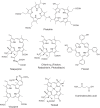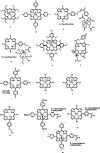Advantages of combined photodynamic therapy in the treatment of oncological diseases
- PMID: 36124276
- PMCID: PMC9481804
- DOI: 10.1007/s12551-022-00962-6
Advantages of combined photodynamic therapy in the treatment of oncological diseases
Abstract
When conducting combined therapy of malignant neoplasms, treatment methods with various mechanisms of antitumor effects are used, while an additive or even synergistic effect can be realized. Combination treatment regimens are aimed at increasing the efficiency and, above all, at the complete eradication of the tumor, which can be achieved either by suppressing the survival mechanisms in PDT-resistant tumor cells or by pre-attenuation of tumor cells so that they become more susceptible to subsequent PDT. Photodynamic therapy is an approved medical technology for the treatment of various malignant neoplasms, and several precancerous and non-cancer diseases. To date, numerous data have been published on the combined use of PDT with traditional and innovative methods of treatment. This review considers research in this area in recent years.
Keywords: Combined cancer therapy; Nanoparticle drug delivery; Photodynamic therapy; Photosensitizer.
© International Union for Pure and Applied Biophysics (IUPAB) and Springer-Verlag GmbH Germany, part of Springer Nature 2022.
Conflict of interest statement
Conflict of interestThe authors declare no competing interests.
Figures







Similar articles
-
Cascade-amplifying synergistic effects of chemo-photodynamic therapy using ROS-responsive polymeric nanocarriers.Theranostics. 2018 Apr 18;8(11):2939-2953. doi: 10.7150/thno.24015. eCollection 2018. Theranostics. 2018. PMID: 29896295 Free PMC article.
-
Supramolecular micelles as multifunctional theranostic agents for synergistic photodynamic therapy and hypoxia-activated chemotherapy.Acta Biomater. 2021 Sep 1;131:483-492. doi: 10.1016/j.actbio.2021.07.014. Epub 2021 Jul 13. Acta Biomater. 2021. PMID: 34265471
-
Delivery of MutT homolog 1 inhibitor by functionalized graphene oxide nanoparticles for enhanced chemo-photodynamic therapy triggers cell death in osteosarcoma.Acta Biomater. 2020 Jun;109:229-243. doi: 10.1016/j.actbio.2020.04.009. Epub 2020 Apr 12. Acta Biomater. 2020. PMID: 32294550
-
Photodynamic therapy as an innovative treatment for malignant pleural mesothelioma.Semin Thorac Cardiovasc Surg. 2009 Summer;21(2):177-87. doi: 10.1053/j.semtcvs.2009.07.001. Semin Thorac Cardiovasc Surg. 2009. PMID: 19822291 Review.
-
Multifunctional Nanoplatforms as a Novel Effective Approach in Photodynamic Therapy and Chemotherapy, to Overcome Multidrug Resistance in Cancer.Pharmaceutics. 2022 May 17;14(5):1075. doi: 10.3390/pharmaceutics14051075. Pharmaceutics. 2022. PMID: 35631660 Free PMC article. Review.
Cited by
-
Red Light and 5% Aminolaevulinic Acid (5%) Inhibit Proliferation and Migration of Dysplastic Oral Keratinocytes via ROS Production: An In Vitro Study.Gels. 2023 Jul 26;9(8):604. doi: 10.3390/gels9080604. Gels. 2023. PMID: 37623059 Free PMC article.
-
Fighting Cancer with Photodynamic Therapy and Nanotechnologies: Current Challenges and Future Directions.Int J Mol Sci. 2025 Mar 25;26(7):2969. doi: 10.3390/ijms26072969. Int J Mol Sci. 2025. PMID: 40243613 Free PMC article. Review.
-
Conjugate of Natural Bacteriochlorin with Doxorubicin for Combined Photodynamic and Chemotherapy.Int J Mol Sci. 2024 Jun 29;25(13):7210. doi: 10.3390/ijms25137210. Int J Mol Sci. 2024. PMID: 39000317 Free PMC article.
-
Photosensitizing effects and physicochemical properties of chlorophyll a derivatives with hydrophilic oligoethylene glycol fragments at the macrocycle periphery.Photochem Photobiol Sci. 2024 Mar;23(3):409-420. doi: 10.1007/s43630-023-00527-w. Epub 2024 Feb 6. Photochem Photobiol Sci. 2024. PMID: 38319518
-
Editorial: Photodynamic Therapy (3rd Edition).Biomedicines. 2025 Jun 11;13(6):1441. doi: 10.3390/biomedicines13061441. Biomedicines. 2025. PMID: 40564160 Free PMC article.
References
Publication types
LinkOut - more resources
Full Text Sources

